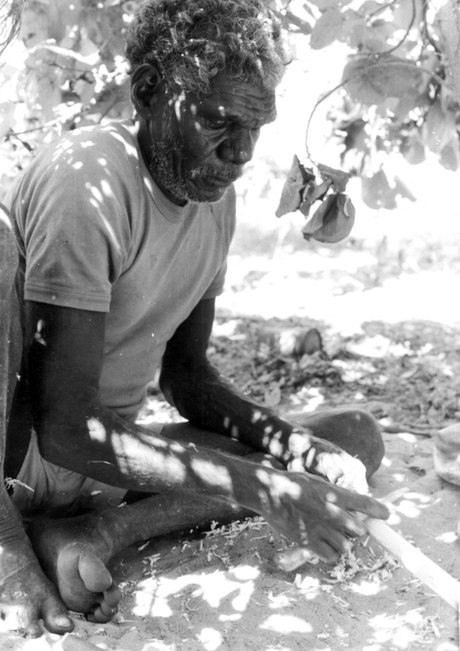NARRITJIN MAYMURU
MARKET ANALYSIS

Photo © Howard Morphy
Narritijin, Mawalan Marika and Munggerawuy amongst others produced grand episodic narrative bark paintings from the 1950s onwards. Narritjin’s, in particular, are both historical recordings and artistic masterpieces. It is not surprising therefore that his highest prices on the secondary market have been for visual complexity images. His record price was set in 2004 for Possum Tree 1964, a painting that differs aesthetically from early figurative Western Arnhem Land bark paintings, which are celebrated for their anatomical detail. Neither do they resemble recent trends toward visual abstraction, as seen in works based on designs from the Mardayin ceremony, by artists such as John Mawurndjurl. For although Narritjin’s designs too, are descended from ceremonial imagery, it is the art of narrative and it’s deep spiritual meaning which is their primary concern. Prior to setting the current record in 2004, his highest price had been $12,650 which had stood since 1999. It is still the only pre 2000 record in the artist’s top ten results. Though it is hard to discern a clear market trajectory 9 of his paintings have sold for more than $5,000 dollars since 2005.
As with most bark paintings the correlation between size and value is often meaningless, with more importance being placed upon the individual quality and condition of each piece. Indeed, his record holding bark measured only 78 by 33.5cm. and his 2nd highest, which sold for $18,409 in 2024 was only 40 x 9 cm. In contrast the large and imposing work Crayfish and Horseshoe Crab at 158.5 by 59 cm failed to sell at Deutscher-Menzies in the same year as the record sale was achieved. Its hefty estimate of $20,000-25,000 indicated the auction houses’ high esteem for a work that was a very fine example, yet even the excellent catalogue entry written by Howard Morphy, failed to help it sell.
Despite the ambiguity of Narritjin’s price fluctuations his work appears regularly at auctions with both affordable and upper range expectations. Only 4 barks have sold for more than $10,000 while 51 barks have sold for less than $5,000. His carvings have sold at very reasonable prices with just one selling for more than $4,500. This is a fraction of the price paid for carvings by several Arnhem Land artists of the period of whom David Malangi and Mick Kubarkku immediately come to mind. Given the quality of Narritjin’s works, they represent wonderful value for those keen to add a work by an important artist from the area to their collection. Investors would need to spend far more lavishly should they want to secure a good work by Mawalan Marika and they may be very pleasantly surprised by looking through the catalogues and comparing the works of these two contemporaries.
Narritjin was an extremely accomplished painter whose works were amongst the most highly regarded during the 1970’s and early 1980’s when they adorned the walls of the earliest primary market Aboriginal galleries like my own. His works were included in a plethora of important museum and touring exhibitions from the late 1940s onward and have been collected by museums and institutions around the world. He is as strong in the literature as almost any other artist in the entire history of Aboriginal art. A technical master of the art of making beautiful and stable bark boards on which to paint, and the soft appeal of his early paintings are enhanced by having been created with orchid juice fixative prior to the use of acrylic binders. Most have lasted in excellent condition and are amongst the most historically desirable works by any of the founders and leaders of the artists of North East Arnhem Land.
This is an artist whose works are inexplicably undervalued in the current market. It seems utterly unrealistic that it should remain that way for long.
© Adrian Newstead

